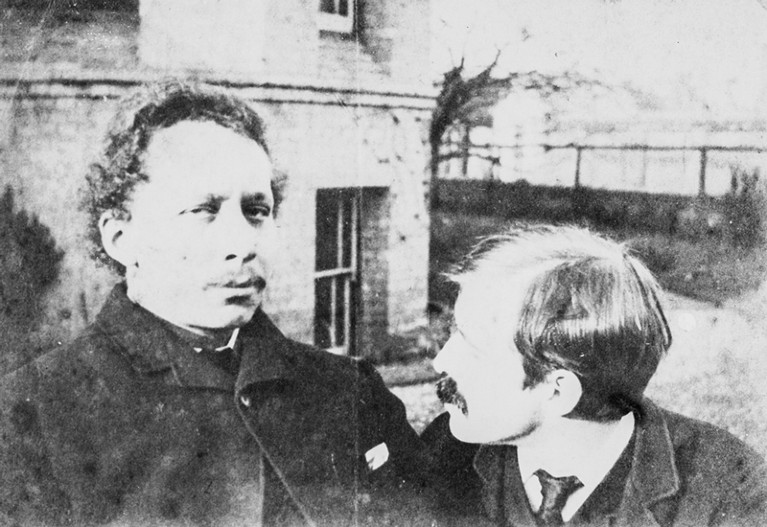
William Bateson (left) and Raphael Weldon had distinct ideas about the nature of inheritance.Credit: John Innes Archives, courtesy of John Innes Foundation
Disputed Inheritance: The Battle over Mendel and the Future of Biology Gregory Radick Univ. Chicago Press (2023)
Between 1856 and 1863, an Austrian monk named Gregor Mendel performed a series of pioneering experiments by breeding plants. Using garden peas (Pisum sativum), he demonstrated that traits such as seed colour and plant height are passed down to the next generation in a 3:1 ratio — three plants with yellow peas for every one with green peas, for instance. Mendel proposed that unknown particles, which he called factors, were the source of this pattern. The type of factor inherited by each offspring determined whether it would have the ‘dominant’ majority or ‘recessive’ minority trait. The monk died before the term gene was coined, but his theories became known as Mendelian genetics.
In Disputed Inheritance, historian of science Gregory Radick provides a scholarly, detailed and perceptive analysis of why Mendelian genetics has long dominated our approach to understanding inheritance, despite valiant attempts to propose alternatives. The answer lies in fierce competition between two scientists in the early days of the field.
Radick divides his analysis into three parts entitled Before, Battle and Beyond. The first section draws together threads of studies from the mid-to-late nineteenth century that analysed inheritance using several approaches, from breeding experiments to statistical analyses of trait variability. These comparisons demonstrate how divergent thinking about evolution and inheritance was at the time.
Two opposing views
Table of Contents
Mendel’s findings drew attention after they were replicated by a trio of botanists in 1900. The focus of many biologists turned to a newly proposed factor, which was named the gene in 1909. Some argued that Mendel’s ideas about the inheritance of these particles could explain how each and every trait was passed down the generations. But others were unsatisfied. The Mendelian way of thinking left no place for the influence of the environment, natural selection and other considerations in heritability.
Radick presents the ensuing debate as a battle over the nature of inheritance — and over the basis of all future studies of biology. The two sides were led by English zoologists William Bateson at the University of Cambridge and Raphael Weldon at the University of Oxford. Friends as undergraduate students, they were driven apart by competition. Bateson was an influential advocate for Mendelian genetics. But Weldon viewed variation in traits as a spectrum — influenced by genes, yes, but also by development, the environment and the ancestral history of each species.

The garden pea, Pisum sativum, was key to Gregor Mendel’s research into heritability.Credit: Alamy
Radick describes how these two men and their supporters defended their positions intensely at public debates and soirées, in journals, and through extensive correspondence. Interactions were often acrimonious. When Bateson was elected to a committee of the Royal Society of London, he used his influence to change the rules to prevent research by Weldon, and other committee members, being published in its journals. Weldon, incensed at what he saw as a deliberate attempt to silence scientific progress, established an independent publication, Biometrika, with his supporters — the eugenicist Francis Galton and his protégé Karl Pearson. Bateson, in turn, dedicated almost half of his 1902 book, Mendel’s Principles of Heredity, to attacking Weldon’s research directly.
A debate about coat colours in mice raged across several issues of Nature from 1902. The colouring of some mice did not follow conventional Mendelian patterns — offspring had blotchy coats, instead of inheriting uniformly coloured fur from their parents. The spat continued at a Zoological Society of London meeting, before which Weldon wrote to a supporter, “We will all take our largest and sharpest carving knives and have a row.”
Radick paints a picture of Bateson and his supporters using increasingly tortured logic to defend Mendel’s laws, as experimental data increasingly suggested a more complex reality that also included environmental and other influences. The battle continued after Weldon died in 1906 — leaving his book, Theory of Inheritance, unpublished.
A long-lasting legacy
In the final section of his book, Radick extends his discussion into the 1940s. By this time, biologists were turning to broader studies of the multitude of processes that influence inheritance, such as the role of different versions of the same gene — known as alleles — and the effects of genes at the level of populations. Nevertheless, no single mechanism of inheritance was sufficient to supplant Mendelian genetics.
Radick also includes an extended analysis of what the history of genetics would have been like had Theory of Inheritance been published. He uses an approach known as counterfactual history, which asks: ‘What if?’ Most historians of biology deplore this approach, but some have used it before. For instance, in his 1989 book Wonderful Life, Stephen J. Gould proposes that rewinding and replaying the tape of life could result in a different outcome. And Peter Bowler’s 2013 book Darwin Deleted argues that no one else could have produced the theory of evolution as Charles Darwin did.

The society that turned Cambridge into a scientific powerhouse
Radick uses counterfactual history to perform an experiment. He outlines a curriculum for an introductory biology class that does not begin and end with Mendelian inheritance, but instead emphasizes developmental contexts. Students who took this class — Radick ran the experiment at the University of Leeds, UK — came away with a less gene-centred and a more enquiring approach to biology than did those who took a more Mendel-focused course (A. Jamieson & G. Radick Sci. Educ. 26, 1261–1290; 2017).
The curriculum is admirable and the experiment fascinating. One caveat is that, since Weldon’s death, many biologists have sought alternatives to Mendelian genetics. By concentrating on Weldon and his unpublished book, Radick plays down these real histories in favour of what could have been.
Take Conrad Waddington, who in 1942 proposed that traits can change before genes do. This occurs, for instance, when fruit flies (Drosophila melanogaster) exposed to ether develop a second thorax, complete with wings, where a wingless abdominal segment should be (C. H. Waddington Evolution 10, 1–13; 1956). Selective breeding of these flies results in offspring that develop a body with two winged segments without further ether exposure. Waddington named this phenomenon ‘epigenetic inheritance’ — epigenetic meaning ‘above the gene’. That this idea was rejected for decades is a testament to the tenacious hold of Mendelian inheritance.
We now know that epigenetic inheritance occurs because of changes that affect gene expression without altering the DNA sequence, such as the addition of heritable molecular ‘tags’ to histone proteins around which the DNA is wrapped. These tags can be induced by environmental changes, bringing us back to Weldon and his emphasis on the environment.
The discovery of epigenetic inheritance reveals a more nuanced theory of inheritance than Bateson would have acknowledged. By describing how the debates of scientists shaped the field of genetics, Disputed Inheritance provides a basis for understanding the work that has led, over the past century, to a richer understanding of heredity than Mendelian genetics could ever have provided.
